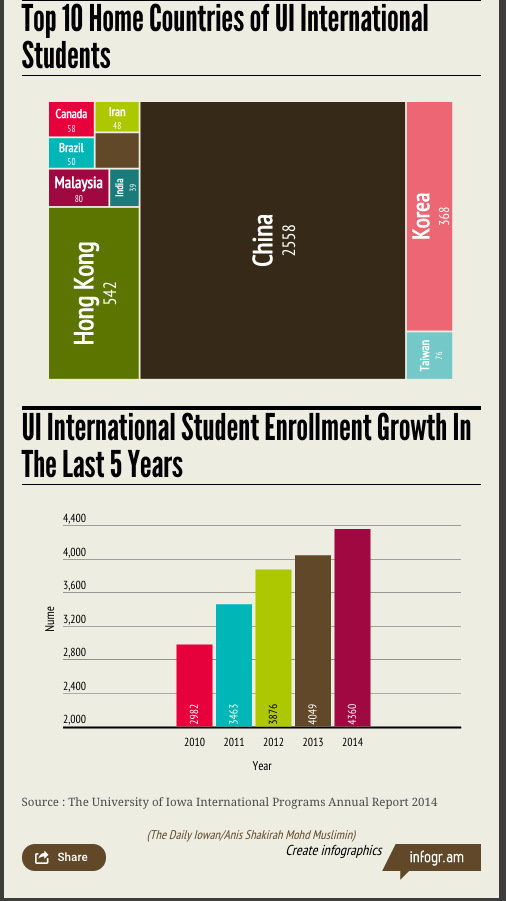By Anis Shakirah Mohd Muslimin
anisshakirah-mohdmuslimin@uiowa.edu
The battle against racism on campus has once again flared up.
International students and Asian American students at the University of Iowa have been targets of xenophobic messages, largely on Yik Yak, a social-media app that allows people to create, view, and vote on anonymous messages.
One recent post read “Guys if we don’t do something soon this university will be more Asian than anything, and if so, I’m leaving …”
Another read “Iowa City? More like Chinatown.”
According to the UI International Programs’ annual report, the roughly 4,400 international students made up nearly 15 percent of the student body in the fall of 2014.
In response to the eruption of messages, the UI undergraduate student and graduate governments released a statement Wednesday highlighting “the urgent need for the campus community to come together to support every campus constituency and to help all feel welcome, valued, and safe on campus, no matter the perceived background or difference.”
In 2013, international students at the UI visibly encountered the same problem when a Twitter account called @UIasianprobz had been reposting negative photos and remarks about Asian students based on how they dress and act.
“I don’t really feel like school officials are doing enough,” said Yihao Zhang, the vice president of the Japanese Student and Scholars Club.
UI Vice President for Student Life Tom Rocklin said everyone should be held accountable when it comes to making changes.
“We see these kind of posts out of ignorance and fear, but another reason they continue is because other students don’t challenge them,” Rocklin said.
Lee Seedorff, senior associate director of International Programs, sent an email to all international students addressing the issue as well.
“For me, the most unfortunate thing the last time this happened was that I did not communicate about it,” she wrote in the email, noting she didn’t make a statement to international students and scholars to recognize the issue.
“I regret that immensely, because over and over again when I have talked to students about this I have heard how they would have appreciated even hearing a simple message to say that the university knows and cares, and asking what would help them feel more supported and safe as members of the UI community,” Seedorff wrote.
Zhang, who is originally from Shanghai, said he believes the perceived inability of international students to assimilate into American culture is one of the main reasons why they often become targets online.
“Even after orientation, the [international students] still don’t know how to live in America,” he said.
Zhang said both domestic and international students are responsible for the cultural disparity on campus.
“The only way to solve the problem is to do it on both sides, but at the same time, you can’t really force any people to do anything,” he said.
Even domestic students who appeared to be “foreign” were written about on Yik Yak.
Goobin Kim, the president of the Korean American Student Association, said he feels the language barrier between domestic and international students makes it hard for the two groups to interact with each other.
“Personally, I feel school officials are doing their best,” Kim said. “It’s just that not a lot of people on campus are aware of cultural diversity.”
Noopur Inani, the UI Student Government diversity liaison, said the student body is currently working with multiple student boards, administrations, faculty members, and organizations in collecting information and responses from students before coming up with an action.
“We are trying to identify the most effective and appropriate way to address the issue, as it involves various identity groups, communities and ethnicities on campus,” she said.
Many programs are available on campus to help international students adjust to being at the UI, Seedorf said via email to the DI.
Efforts include the Building Our Global Community program, Bridging Domestic and Global Diversity program, and the Global@Iowa classes.
There are also general diversity and cultural competence programs for faculty and staff members, she said.
“It’s very difficult for the university to respond in a sense of stopping it directly,” Rocklin said. “We can’t control what shows up on Yik Yak or Twitter, so our only opportunities are through education.”




